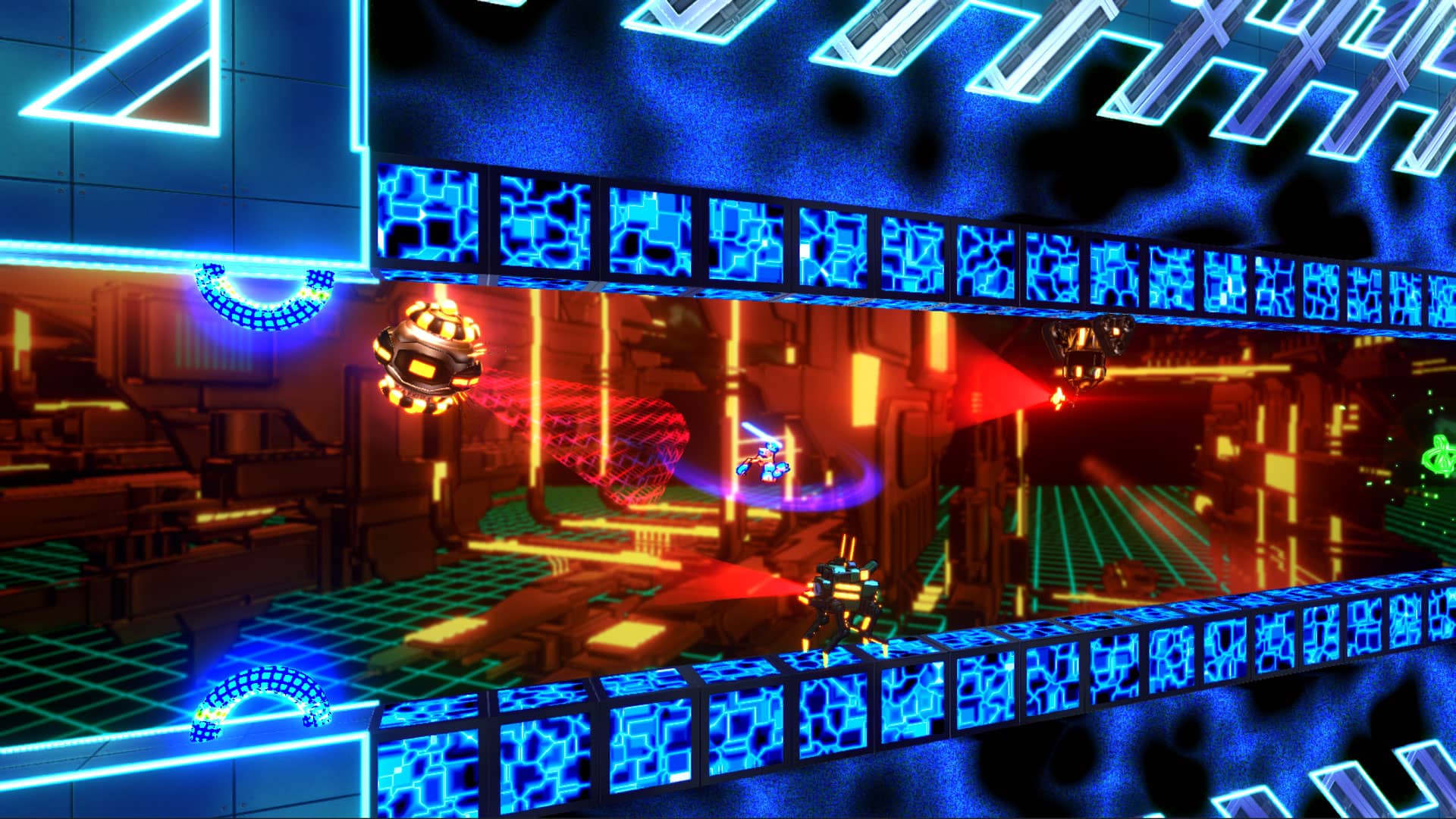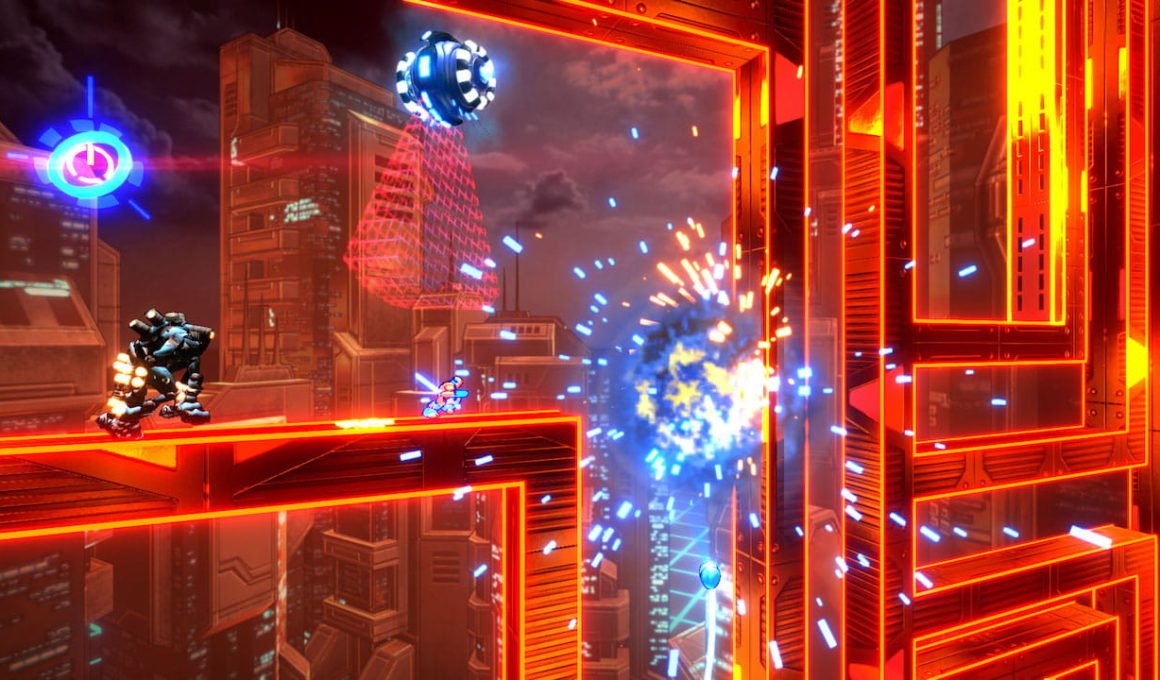Exception is a fast-paced topsy-turvy action-platformer where you play as a computer thread transformed into an elite Malware killer. Equipped with a powerful anti-virus lightsaber, it’s down to the small micro machine to bring peace and prosperity back to the mainframe, whilst overthrowing the dictatorship of the malicious intruder known only as Titan.
Speed is key as you jump, wall hop, and slice your way across transforming neon-infused levels plagued with corrupt programs. Each stage is short, sweet, and somewhat reflects precision platforming and combat elements of games such as Super Meat Boy and Katana ZERO. Exception’s main feature lies within how the stages themselves dynamically rotate and transform into various planes when striking pretzel-shaped icons littered throughout the joint. It’s a cool mechanic in its own right, but one that can often struggle to live up to its full potential.
The stages have a timer slapped at the top-center of the screen to make speed-running an obvious and exciting rule to abide by. Furthermore, the way the stages quickly spin into place to open up new pathways enhances the rush of wanting to burn towards the goal even faster. Up to four Angry Bird-style stars are rewarded on each stage as a measurement of your efforts, which are then compiled together to obtain new attack abilities when quotas are met. While these are all ideal ingredients to make for a fun and addictive challenge, it’s hard to look past the main character’s clumsy movement and the overall repetitiveness of the level design.

Although interesting on the eye at first, the aesthetics of the stages consist of very little variety outside of the Rubik’s Cube mechanic that the game so heavily depends upon. The color palette slightly changes somewhat, but after blazing through well over 100 stages it soon becomes difficult to separate the personality from one area to another. Replaying stages to earn the maximum stars, grabbing hidden collectible circuit chips, and landing a place on the online leaderboards are all hindered by blurred lines of similarity and repetition. As a result, I soon found that I really had no desire at all to replay stages as making my way through the main campaign alone soon became a bit of a chore.
Despite how Exception may appear to play like at a glance, pretty much every stage has a paint by numbers linearity to its design. The whole rotating gimmick is clearly begging to be used more intricately as a deeper puzzle mechanic more than it seems to want to. Besides a few switches to flick, collectible circuit chips to find, and a cluster of generic boss fights to battle, the awkward sprint between point A to point B is pretty much the head and tail of what to expect.
The choice in focusing more on speedrunning as opposed to puzzle solving in itself is not necessarily a bad thing. After all, Exception can feel at its best when a stage constructs itself in a way to keep the rhythm going. Unfortunately though, the stage layout rarely ever tailors for the opportunity to hit a flow at a consistent pace. That’s not to say that it is impossible to sweep through Exception in an effortless style with practice and understanding. But the gameplay aspects in place do make things far more difficult than they really need to be. To put it bluntly, I found controlling the character in Exception an absolute ballache to deal with.

Like I stated earlier, Exception looks, feels, and sets its clock towards precision platforming and speed. Yet, I found it impossible not to be turned off by the floaty, almost drunken Bomb Jack-style jump mechanics. Just trying to navigate within the window of a jump arch felt like I was constantly fighting against the commitment. It also seemed like there was a bit of input latency in how timing a jump at the edge of a platform would often lead to plummeting to my death, regardless of how confident I was in performing it.
I’m sure that Traxmaster Software employed a control system to fit their vision, but, given its nature, the movement just didn’t seem to mold well with me in the way that my brain and coordination have been trained to expect. It’s not even like I found the game too difficult to deal with either. As a matter of fact, I would find myself completing at least 75 percent of the stages under five tries on average. Sure, hitting four stars on every stage is where the challenge is really at, but the overall inability to enjoy handling the character ultimately felt disruptive in wanting to master them.
If low gravity controls do happen to be your bag, then Exception really isn’t that bad of a game. It is clean enough to look at and contains some really nice touches and effects such as the screen becoming more pixelated the more damage the hero takes. The ’80s style synth music also fits the tone adorably well and there are some genuinely good level design mechanics hidden within the noise. Furthermore, the way Exception provides the choice to save each unlockable story segment as opposed to force-feeding their dramatic masterpiece is a thoughtful way not to break the beat of the gameplay.
Watching the trailer for Exception beforehand gave me the confidence that this was going to be one of those delightful surprise drops that are the perfect fit for handheld play. It’s a real shame that wasn’t the case as I can honestly see a good game hidden behind the fog of repetitive level design and a less than desirable control system. The whole flip mechanic is a genuinely good idea pressed further in how everything instantly folds back to the beginning in failure. It’s just unfortunate that when sewn together, Exception struggles to learn from the 2D platformers that it clearly draws inspiration from.
Version Tested: Nintendo Switch
Review copy provided by Traxmaster Software





